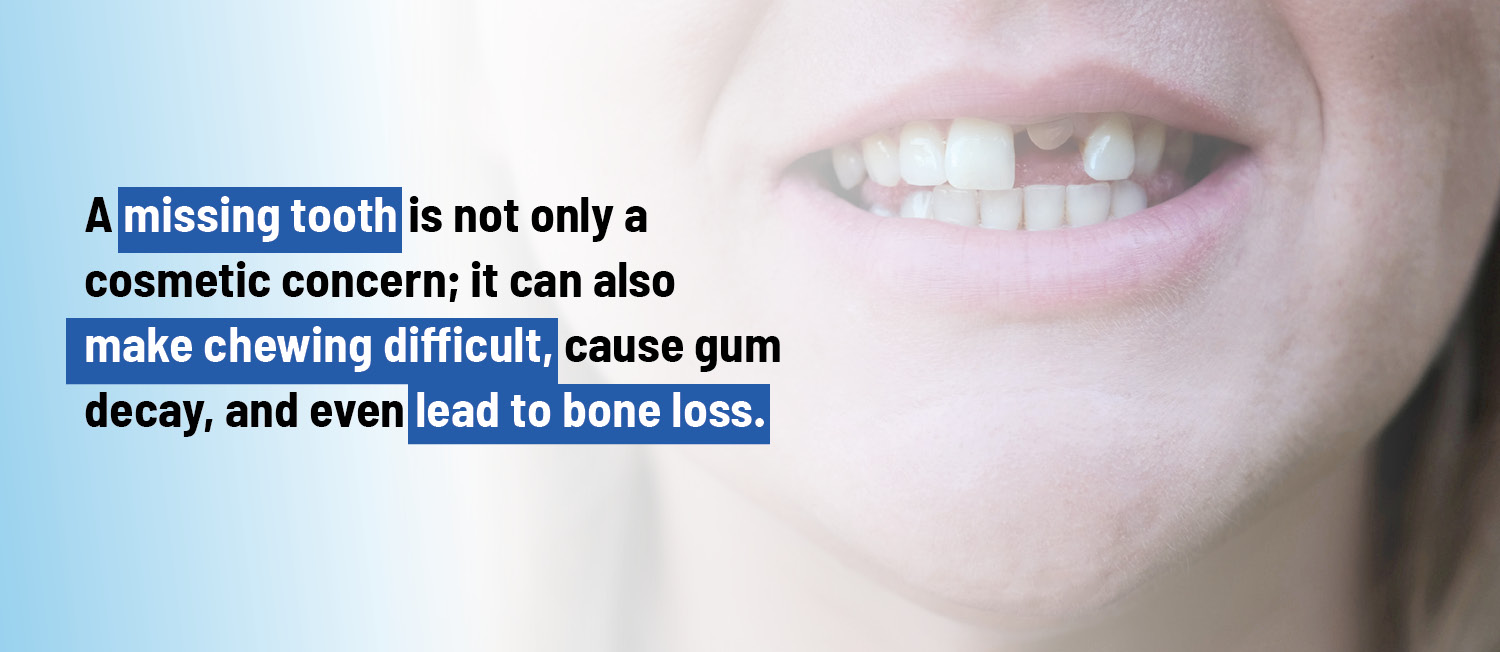A missing tooth is not only a cosmetic concern; it can also make chewing difficult, cause gum decay, and even lead to bone loss. Filling the space promptly is the best way to prevent major dental issues, but is a bridge or implant better? We will discuss the benefits and drawbacks of each.
Is a Bridge or Implant Better?
When it comes to dental implants vs. a bridge, the best tooth replacement option depends on a patient’s overall preferences, health, and budget.
Pros and Cons of a Dental Implant
Dental implants are the most permanent solution for missing teeth. The procedure takes several steps, including:
- Reducing the chances of gum disease.
- Preserves the jawbone. Because they are fused to the bone, implants keep the jawbone from deteriorating and maintain the natural shape of the face.
- Can last a lifetime. Implants last from 10-30 years, and even longer in those who practice excellent oral hygiene. Patients who focus on maintaining healthy bones by eating a healthy diet and taking calcium supplements tend to have implants that last the longest.
However, dental implants are not for everyone. Disadvantages include:
- Upfront cost. Insurance does not always cover implants if they consider it a cosmetic procedure. Depending on if or how much dental insurance will cover, the cost of dental implants vs. a bridge can be a much bigger investment.
- Surgical risks. Although rare, surgery poses risks of infection at the implant site, sinus problems if placed in the upper jaw, and damage to surrounding teeth, blood vessels and nerves. Patients with cancer, uncontrolled diabetes, and auto-immune disease may not be able to safely undergo implant surgery.
- Timeline. The entire dental implant procedure can take up to a year. Although a temporary space filler such as a flipper tooth can be inserted for aesthetic purposes, some patients prefer a more immediate treatment so they can get back to chewing as usual.
Pros and Cons of a Dental Bridge
A dental bridge is a non-surgical procedure in which a false tooth is anchored between two permanent teeth to fill in a missing space. Unlike dentures, which are removable, dental bridges stay in place. The procedure can usually be completed in two steps:
- At the first appointment, the teeth on either side of the gap are ground down to fit crowns. The dentist will also take impressions to create an artificial tooth and crowns that look similar to the natural teeth.
- When the bridge is fabricated, the dentist will bond the bridge to the prepared teeth.
A dental bridge offers advantages including:
- No surgery. Instead of being implanted beneath the gums into the jawbone, the false tooth sits on top of the gums. This makes a bridge a good option for those who are at risk of surgery complications, as well as those who have insufficient bone for implant placement.
- Faster completion. Patients who don’t want to dedicate many months and several appointments to the implant process may choose a dental bridge for more immediate results.
- Lower upfront cost. The price of a bridge is less than an implant to begin with, and some dental insurance providers cover up to 80% of the cost.
- Can span across multiple spaces. If more than one tooth is missing, the gap can be filled with a longer bridge rather than implanting multiple artificial teeth.
Some patients may not like the disadvantages of a bridge, including:
- More frequent maintenance. A bridge is only made to last up to 10 years before it starts to break down, and that requires spending more money on a replacement.
- Compromises adjacent teeth. Grinding adjacent teeth in order to fit crowns removes enamel, exposing them to damage. Some dentists don’t recommend drilling perfectly healthy teeth and instead recommend dental implants.
- Higher risk of tooth and gum decay. Food and debris are likely to get trapped under crowns and bridges, so brushing and flossing with a threader are essential to preventing gum disease and cavities.

Implant vs. a Bridge for Molars: Which is Best?
Molars in the back of the mouth are used to eat 90% of food, so those teeth need to be strong enough to withstand the pressure of biting down and chewing. Because an implant actually fuses with the bone, it preserves the integrity of the jawbone for optimum biting pressure. An implant is also anchored to the gums just like a real molar, making it possible to chew crunchy snacks and tough meat. When asked “is a bridge or implant better for replacing a molar”, dentists recommend an implant the majority of the time.
Ask a Dentist Which Type of Tooth Replacement Will Work for You
Every patient is different, so when it comes to dental implants vs. a bridge, you should rely on a dentist’s expert advice. He or she will evaluate your overall health condition to determine which option is safest, and which method will meet your aesthetic goals. Contact a dentist near you today.


